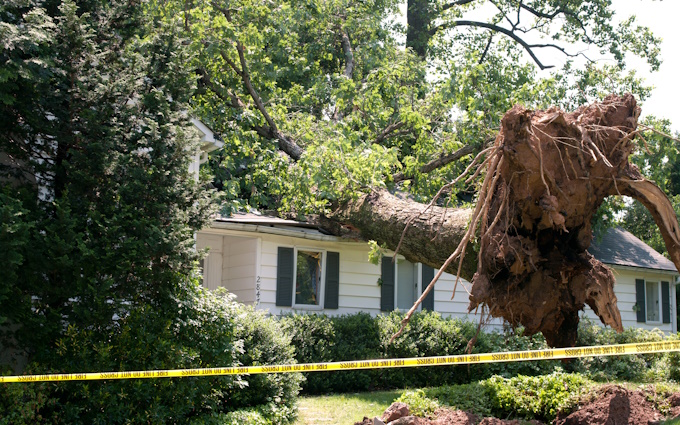An Arborist in Kansas City Can Provide Professional Assistance Removing Fallen Trees
A large tree limb falling on your house is a stressful experience, potentially posing immediate safety concerns and significant property damage. Midwestern spring and summer storms have a way of testing trees’ limits.
As a homeowner, knowing how to respond to a tree that’s fallen onto your home means you can safely navigate the situation and recover more smoothly. It’s also important to understand what your homeowner’s insurance will cover in terms of debris cleanup and tree removal. Regardless of your coverage, you likely need to contact an arborist or tree surgeon for removal and clean-up services. This is especially true for large, unmanageable fallen branches or tree trunks.
After explaining how to respond to a tree falling onto your home, we’ll discuss some key insurance details and the value of consulting with an arborist during emergency tree situations.
A Tree Has Fallen onto Your Home – Now What?
- Confirm everyone is safe: Immediately evacuate the impacted area. Ensure all household members are accounted for and free of injury. Avoid entering the damaged area until professionals have confirmed it’s safe to do so, as there may be hidden dangers such as structural damage or live power lines.
- Contact emergency services: If the fallen tree has caused a life-threatening situation or if there are downed power lines, call 911 or your local emergency services right away.
- Document the damage: After it’s safe, take photos and videos of the damage from various angles, ensuring you have detailed records for insurance purposes. Documenting everything before any cleanup or repairs begin is essential.
- Contact a professional tree service: A tree service can methodically break down and remove the fallen tree, reducing the risk of incurring further property damage. Look for companies that offer emergency tree removal services to help expedite the process. The other advantage of contacting a professional tree service is that they either have certified arborists or trained arborists on staff who can check the health and integrity of what remains of your tree. Although a handyman-type service can perform clean-up, they won’t bring the expertise necessary to evaluate the ongoing safety of your property.
- Check your homeowner’s insurance policy coverage: Pull up your most current homeowner’s insurance policy and refamiliarize yourself with how your coverage handles fallen trees. Most policies cover debris cleanup after your deductible, but not the removal of the rest of the tree. Remember to keep all invoices related to tree removal. Your insurance provider will ask for copies during the claims process.
Important Homeowner’s Insurance Considerations
In the event of a tree emergency, it’s important to know what your homeowner’s insurance policy covers. Most policies will cover tree-related damage to the home if it was caused by perilous weather events. However, if a tree falls onto your home because it’s dead or diseased, your insurance provider could attempt to attribute that to homeowner negligence and deny the claim.
Another important detail to be mindful of is debris cleanup versus tree removal. Carefully read through your policy to confirm which scenarios are covered and the specific conditions that trigger them. Some policy holders will be surprised to find that an uprooted tree that causes no property damage can’t be claimed.
Finally, if your home is uninhabitable due to the damage, your policy may also cover the cost of temporary housing and other living expenses while repairs are being made. Read through your policy to confirm if this is included with your coverage.
The Advantage of Working with an Arborist in Kansas City
Whether your tree is uprooted, structurally compromised, or showing signs of rot or disease, working with an arborist offers several significant benefits. Here are the key advantages:
- Expertise and experience: Arborists possess extensive knowledge about various tree species and their specific needs. This expertise allows them to assess whether a tree indeed needs to be removed or if there’s a possibility to save it through treatment or pruning.
- Safety: Removing a tree, especially a large one, is a tricky endeavor. Arborists and tree surgeons use their specialized training and equipment to perform the task safely, minimizing the risk of injury to themselves and others, and preventing damage to nearby property.
- Compliance with regulations: Certain counties may have specific regulations regarding tree removal. An arborist near you will be familiar with these laws and can ensure that the removal process complies with all local, state, and federal regulations, avoiding potential fines.
- Cleanup: Yard cleanup is a significant part of the tree removal process. Thorough arborists will not only remove the tree, but also deal with the debris, leaving your property clean and tidy.
- Preventative advice: Arborists can provide valuable advice on how to maintain the health of other trees on your property, potentially preventing future problems and removals.
Contact an Arborist in Kansas City for Emergency Tree Care
A tree falling on your house can be an overwhelming experience, but understanding the proper steps to take can significantly reduce your stress and ensure a more streamlined recovery process. Prioritize the safety of your family, document everything, enlist the help of a trusted tree care service, and get up to speed on your home insurance policy coverage.
Knowing the coverage details of your homeowner’s insurance policy will prepare you for the financial aspects of debris cleanup, tree removal, and repairs. It’s always advisable to review your policy regularly and consult with your insurance agent to clarify coverage limits and any exclusions.
Finally, if you’re concerned about the health and resilience of your trees, take the proactive step of contacting an arborist near you for a comprehensive inspection. By getting a head start on addressing potential issues, you can ensure your trees are prepared to endure the high winds and heavy rains Midwestern storms bring.

